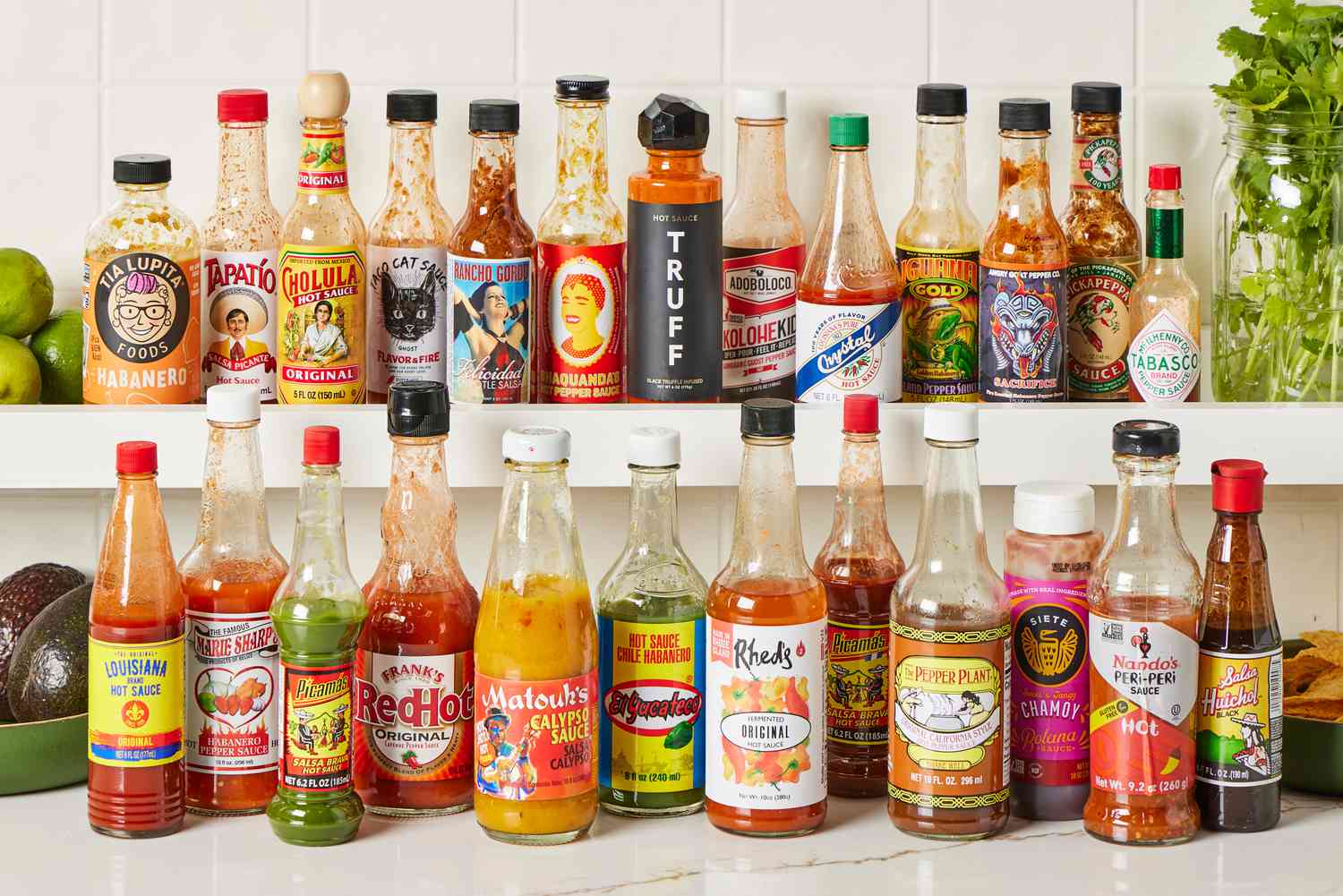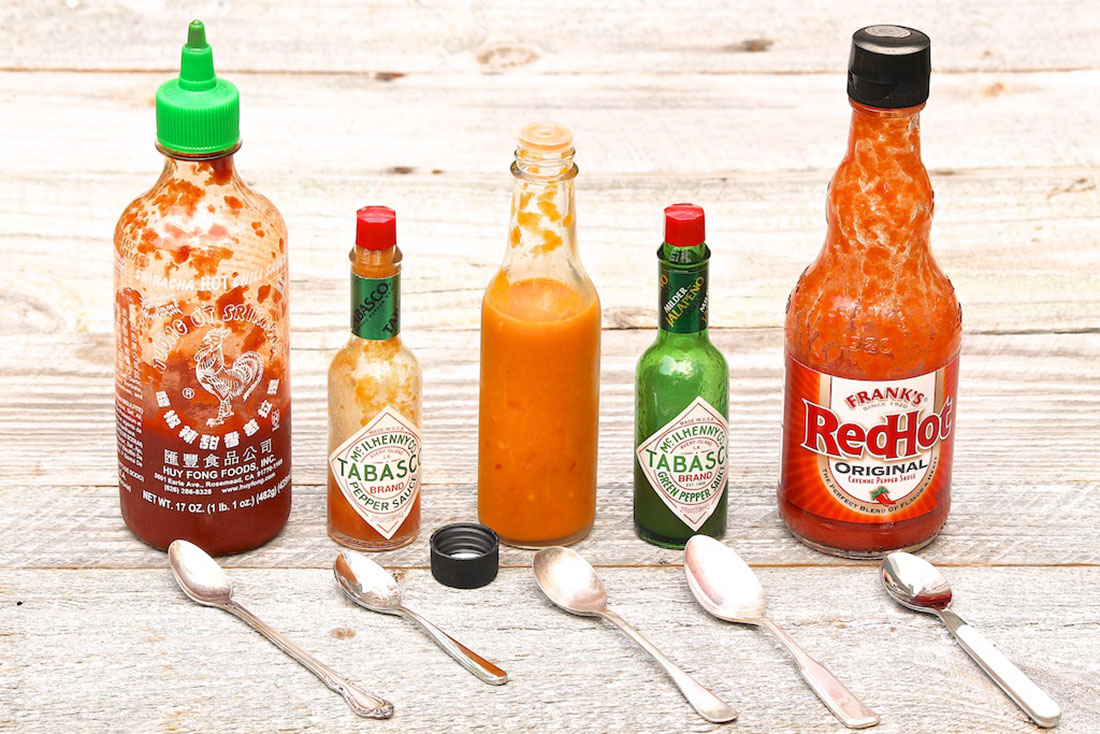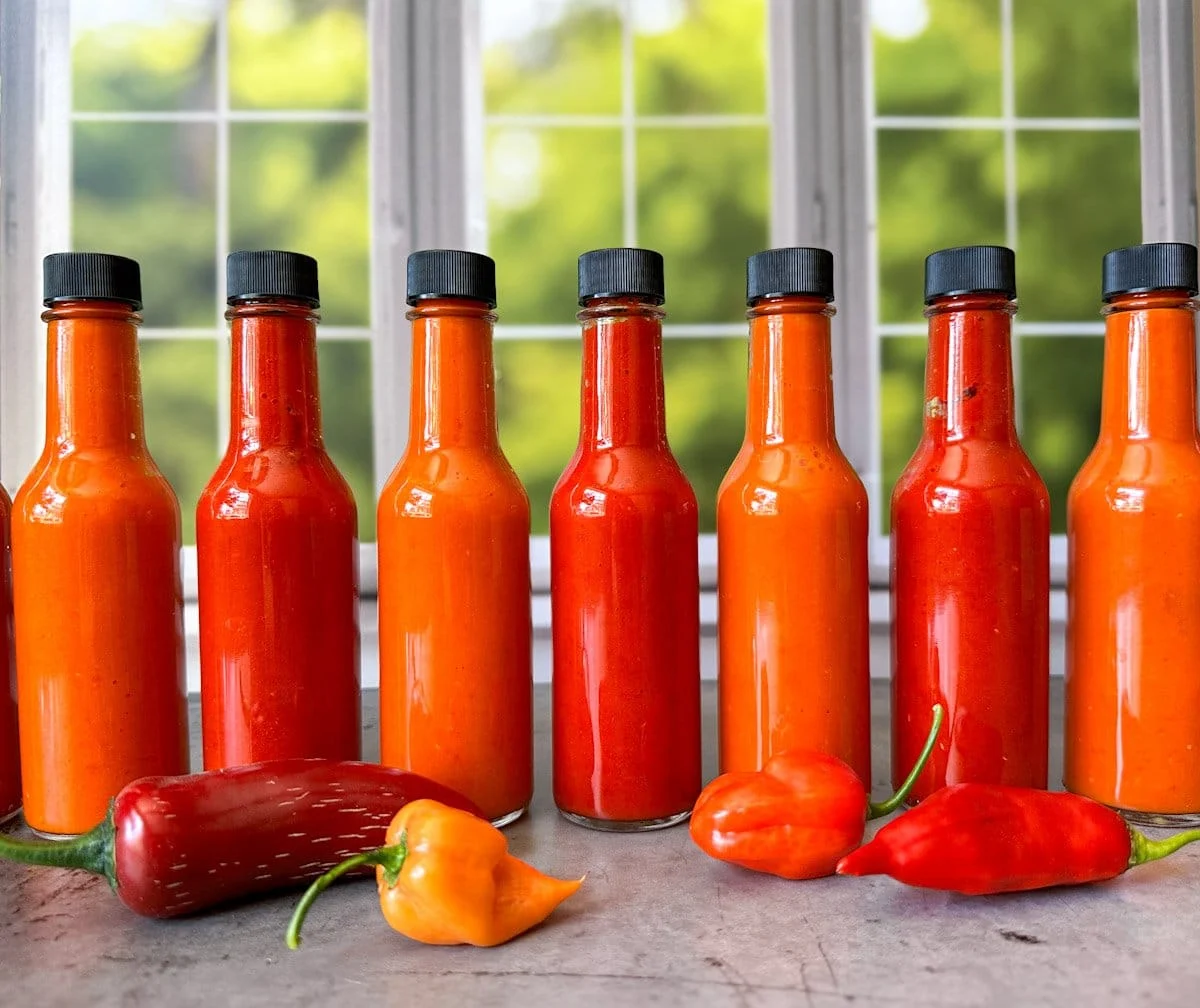Have you ever noticed that hot sauce almost always comes in small bottles? Unlike ketchup or mustard, you won’t find giant-sized options on the shelf. The reason for this isn’t a conspiracy, but simple practicality. Since hot sauce is used in small drops for its intense heat and flavor, a little goes a very long way. A large bottle would likely expire long before you could use it all.

Table of Contents
Potency and Portion Control
Hot sauce bottles are intentionally small—typically holding between 3 to 5 ounces (approximately 89 to 148 ml)—due to the intense potency of the sauce inside. The compact size helps prevent accidentally overpowering a dish with too much heat or flavor.
A key element in portion control is the use of woozy bottles, which have become the industry standard. They come in various sizes, with the 5 oz (around 148 ml) version being among the most popular. These bottles often include special tops such as dasher inserts or orifice reducers, allowing the sauce to be dispensed one drop at a time. This is especially important for extremely spicy, high-Scoville sauces, where just a few drops can significantly alter a meal.
The bottle’s narrow neck and small opening—usually between 18–24 mm—also help slow down the pour, giving users better control over how much sauce they use. To maintain freshness and prevent leaks, most bottles are sealed with foam-lined screw caps or swing-top closures. These caps not only preserve the sauce but also work together with the small opening to support measured, drop-by-drop usage.
A typical 5 oz woozy bottle stands about 6–7 inches tall, with a base diameter of 1.75–2.5 inches. This practical and user-friendly size makes it easy to handle and store. Ultimately, these design features work together to support efficient portion management, reduce waste, and offer a safer way to enjoy even the spiciest hot sauces.
Preservation of Flavor and Heat
Hot sauce is commonly sold in small bottles to help preserve its signature flavor and heat over time. Several key design and compositional factors contribute to this effect.
glass bottles are widely used because glass provides an excellent barrier against air and moisture, helping to protect both the complex flavor compounds and the capsaicin—the active component responsible for heat—from degrading. Additionally, most hot sauces have a pH below 4.0, making them highly acidic. This natural acidity not only inhibits microbial growth but also helps maintain flavor consistency throughout the product’s shelf life.
Using a smaller bottle also means less sauce is exposed to air each time it’s opened, significantly slowing down oxidation. This allows the hot sauce to retain its original taste and spiciness longer. Unopened, a bottle of hot sauce can last up to two years. Once opened and refrigerated, its flavor remains at peak quality for about 6 to 12 months. For those who don’t use hot sauce frequently, a small bottle is ideal—it’s more likely to be finished before the flavor weakens.
This is especially useful for fermented hot sauces and others with high acidity, which are generally more stable. The small bottle offers an extra layer of assurance that the sauce will be consumed before any loss of intensity occurs.
It’s also important to consider storage conditions. Exposure to sunlight and heat can break down both flavor and capsaicin over time. Storing hot sauce in a cool, dark place—such as a pantry or refrigerator—helps maintain its freshness and punch for as long as possible.
Keeping Your Hot Sauce Fresh
The freshness of hot sauce depends on both its ingredients and how it’s stored. Small bottle designs play a key role here—they’re not just practical, but also help ensure you enjoy the sauce while it’s still at its best.
When it comes to shelf life, the type of ingredients makes a big difference. Vinegar-based hot sauces tend to last the longest. Thanks to the natural preserving qualities of vinegar and capsaicin, an unopened bottle can stay good for two years or more, often well past its “best by” date. Once opened, refrigeration can keep these sauces fresh for another one to two years. On the other hand, sauces made with fresh fruits or vegetables have a much shorter lifespan. Unopened, they might last 6 to 12 months, but once opened, they should be used within just one to two months. Craft hot sauces, which often contain fewer stabilizers and more natural ingredients, typically remain good for about 3 to 6 months when refrigerated after opening.
How you store your hot sauce really matters. Refrigeration is always recommended—it helps preserve both the flavor and the heat, especially important for sauces containing fresh ingredients. If you leave an opened bottle at room temperature, its quality will decline faster. Even vinegar-based sauces can lose their punch and taste within a year if not refrigerated.
Many hot sauce bottles come with a “best by” date, usually around two years for unopened products. In reality, especially with vinegar-based varieties, they can often last well beyond that. The small bottle size encourages quicker use, which helps you finish the sauce while it’s still fresh and full of flavor. This way, you get the most out of its taste, aroma, and heat every time.
Consumer Convenience and Portibility
Small hot sauce bottles are perfectly suited for today’s fast-paced, on-the-go lifestyle. Their compact size offers practical advantages that larger bottles simply can’t match.
These small bottles, especially the standard 5 oz size and even smaller options, are designed for easy portability. They slip effortlessly into lunch boxes, backpacks, or even a car’s glove compartment, making it simple to bring your favorite hot sauce to restaurants, friends’ gatherings, or on road trips. For people with busy schedules, having a small bottle on hand means they can quickly enhance meals at work, school, or wherever they happen to be eating—adding a personal touch to takeout or a homemade lunch.
Small bottles also encourage experimentation. They allow people to try new flavors or brands without committing to a full-sized bottle, reducing the risk of ending up with a sauce they don’t enjoy. This approach aligns with modern consumer preferences—more than 67% of U.S. consumers say they enjoy trying new condiments when they come in small packages. For brands, these mini bottles serve as an effective way to attract new customers.
From an e-commerce perspective, smaller bottles are easier and cheaper to ship. They can be bundled into sample packs or themed gift sets, which have become particularly popular among Millennials and Gen Z shoppers who value variety and discovery.
Another benefit is reduced waste. For those who don’t use hot sauce frequently, a smaller container means less chance of spoilage or accidental over-pouring. It’s a practical choice that supports freshness and portion control. Whether for convenience, variety, or minimizing waste, the small hot sauce bottle delivers smart solutions for everyday use.

Reduced Product Waste
Hot sauce producers often opt for small bottles not only for practicality but also to minimize waste. Since hot sauce is typically used in small amounts due to its intense flavor, smaller containers help ensure the product is fully used while still fresh, reducing the chance of spoilage or discard.
Smaller bottles limit the sauce’s exposure to air each time they’re opened. Because most people use only a few drops at a time, a large bottle might sit open for months, increasing the risk of flavor loss or spoilage. A smaller size encourages faster consumption, which means users are more likely to finish the bottle while the sauce is still at its best.
Many small hot sauce bottles also come with dropper tops or narrow openings that support better portion control. This helps prevent over-pouring, especially important with extra-spicy sauces where a little goes a long way. As a result, less product is wasted with each use.
From an environmental perspective, smaller packaging leads to less material waste. If a consumer tries a new flavor and doesn’t like it, there’s less leftover sauce and packaging to throw away. Even a small shift toward moderately sized containers can meaningfully reduce plastic waste over time. Although the hot sauce market is relatively small—representing just 0.7% of Spain’s sauce market in 2019, for example—efficient packaging ensures more of each bottle is actually used, leading to less unused product in landfills.
Additionally, small bottles are portable and convenient. People often bring them to restaurants, on trips, or to work, making it easier to use the sauce regularly and finish it before quality declines. On the production side, many manufacturers have also improved sustainability by repurposing by-products such as capsaicin, pepper oils, and natural colorants into other items, further reducing waste.
Overall, small bottle designs help deliver a fresher product, minimize waste, and support more sustainable consumption.
Why Small Bottles Are Smart for Hot Sauce Makers
For hot sauce producers, using small bottles isn’t just a packaging choice—it’s a smart business strategy that supports cost efficiency and faster sales.
Producing hot sauce in smaller volumes helps keep ingredient costs manageable. A basic jalapeño hot sauce might cost around $0.16 per ounce to make, adding up to roughly $0.82 for a standard 5 oz bottle. More complex recipes with additional ingredients can raise the cost to about $1.32 per bottle. By sourcing ingredients in bulk, producers can reduce expenses by over 70%, making small-batch production more affordable. Starting a hot sauce business can be relatively low-cost too—sometimes under $50,000 when using rented equipment or co-packing services. Larger operations might require an investment between $110,000 and $380,000, though most of that goes into facilities rather than packaging.
Glass is the preferred material for hot sauce bottles because the acidity in the sauce can break down plastic, which would require additional preservatives. The 5 oz Glass Bottle has become an industry standard—it’s what customers recognize and expect. Buying these bottles in bulk further brings down the unit cost. Smaller bottles also allow manufacturers to run more flexible production cycles, reducing the risk of waste from unsold or expired inventory.
Equipment costs can be controlled as well. Industrial mixers typically range from $30,000 to $100,000, and bottling lines from $20,000 to $70,000—affordable for many small to mid-sized producers. This level of automation supports efficient small-bottle production without overspending.
From a sales perspective, small bottles tend to sell faster due to their lower price point. This helps manufacturers maintain steady cash flow and keep products fresh on shelves. Offering a variety of small-bottle SKUs also allows companies to adapt more easily to market trends and reduce hidden costs like storage fees.
Finally, small bottles encourage repeat purchases. Customers often buy them to sample new flavors, use as gifts, or keep at home for daily use. This not only boosts sales volume but also strengthens brand visibility and loyalty. For hot sauce makers, small bottles offer a practical way to protect profits, reduce risk, and support sustainable growth.

Suitability for Gifting and Events
Small hot sauce bottles have become a popular choice for gifts and special events thanks to their convenience, unique appeal, and easy customization. Many brands now offer thoughtfully designed gift packs, such as Merline’s Caribbean Hot Sauce, which includes three 8 oz bottles in a set. Customers can often select their preferred flavors and even include a personalized message when sending it as a gift. These sets are especially well-received during holidays or as birthday presents, offering recipients a chance to explore new tastes in an attractive package.
For events like weddings, bridal showers, or themed parties, mini hot sauce bottles—typically between 1.7 to 1.75 oz—serve as fun and memorable favors. Sold in bulk quantities of 12 or more, these small bottles can be customized with labels or stickers that align with the event’s theme or feature the names of the hosts. Marketing language such as “party favors” or “guest gifts” is often used to appeal to event planners looking for something a little different.
Sampler sets are another hit for special occasions. The Master Hot Sauce Sampler, for example, includes 30 different mini bottles, offering an extensive tasting experience that works for an individual or a whole group. These sets are often described as exciting and unconventional gifts.
Hot sauce also finds its way into corporate and fundraising settings. Organizations often use custom-labeled bottles as giveaways or donor thank-yous. Rowan University, for instance, successfully used Houshmand’s Hazardous Hot Sauce in a scholarship campaign, raising millions of dollars while offering the sauce as a token of appreciation. This approach frames hot sauce not just as a condiment, but as a symbol of participation and support.
Media outlets have begun recognizing hot sauce gift sets—such as Melinda’s Chef Fig’s Heat and Flavor Collection, which includes six 2 oz bottles—in gift guides, often highlighting them as affordable and distinctive options, particularly during the holidays.
Whether in small mini bottles for weddings or curated sampler packs for corporate gifting, the small format offers practical advantages: it’s easy to distribute, cost-effective to customize, and makes for a memorable experience. This versatility and personalization are what make small-bottle hot sauce an ideal fit for so many celebratory and promotional occasions.
Conclusion
In summary, hot sauce is sold in small bottles for a variety of practical and strategic reasons. From preserving flavor and heat to enabling portion control, reducing waste, and supporting cost-effective production, the compact size serves both producers and consumers alike. Small bottles also align perfectly with modern trends such as on-the-go convenience, gifting, and product sampling, making them a smart and versatile choice in today’s market.
At TP Glass Bottle Manufacturer, we understand the unique needs of hot sauce producers. Our high-quality, customizable glass bottles are designed to protect your product’s integrity while enhancing its shelf appeal. Whether you’re launching a new flavor or expanding your line, we provide reliable, scalable packaging solutions that help your brand stand out. Let us help you bottle the heat—perfectly.

